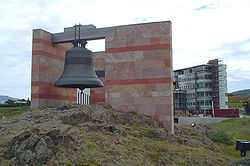University of Akureyri
| University of Akureyri | |
|---|---|
| Háskólinn á Akureyri | |
 | |
| Established | September 5, 1987 |
| Type | Public |
| Chancellor | Eyjólfur Guðmundsson |
Academic staff | ca. 100 |
Administrative staff | ca. 180 |
| Students | ca. 1,400 (August 2013) |
| Undergraduates | ca. 1,200 (August 2013) |
| Postgraduates | ca. 400 (August 2013) |
| Location | Akureyri, Iceland |
| Colors | Red |
| Nickname | HA |
| Affiliations | EUA, UArctic |
| Website | http://www.unak.is/ |
 | |
The University of Akureyri (Icelandic: Háskólinn á Akureyri) was founded on September 5, 1987 in the city of Akureyri in the north-eastern part of Iceland. It has grown since then, especially in the last few years as more facilities have been established. Over 1600 students attended the university in the autumn semester of 2013, around half of them through distance education, making the university the largest provider of distance education in the country. Also, the enrolment at the University of Akureyri makes up 9% of the entire university enrolment in Iceland.
History
The University was established in 1987 when the health sciences and industrial management studies began. The first rector was Haraldur Bessason. Staff were four people in total and the number of students 31. Two classrooms in the local sports center were used as classrooms. In 1988, the library was officially added to the school. Two months after the library was added, the Student Center opened. The first class to graduate was in 1989, and consisted of 10 industrial management students. On January 4, 1990, the Faculty of Fisheries was established. The first master's degree students graduated February 26, 2000. These students pursued a master's degree in nursing. A new chancellor took over from Þorsteinn Gunnarsson in the 1.st of July 2009 after 15 years in office, Stefán B. Sigurðsson.
Campus

The main building, called Sólborg is a series of interconnected sections built in numerous phases since 1967. The University received its current residence in 1995.[1] A new research and development building called Borgir was opened in 2004.
Faculties
Since autumn 2009, the university has the following faculties:
- School of Humanities and Social Sciences (Hug- og félagsvísindasvið)
- School of Health Sciences (Heilbrigðisvísindasvið)
- School of Business and Science (Viðskipta- og raunvísindasvið)
Research
Most research is done by academic members of the staff in the university's Research and Development Center. In addition, there are four other research institutes:
- Research and Development Centre of UNAK
- Research Centre on Children's Literature
- Research Centre for Health Science at UNAK
- The Icelandic Tourism Research Centre
- Centre of School Development at UNAK
- Research Centre Against Violence
- Fisheries Science Centre
External Relations
International Students
Each year the school receives more exchange students. These students come through one of four exchange programs:
- Nordplus
- Erasmus
- North2North
- Bilateral agreement between universities
Students can come as guest students. This occurs when a student attends the university for a short period of time, but there is no formal co-operation between universities. Not only do students travel, but so do teachers. Through the Erasmus program, teachers have travelled to co-operating universities and given lectures. This exchange of teachers has taken place in many countries including: the United Kingdom, Denmark, Latvia, Germany, Italy, Sweden, Austria, Belgium, and France.
References
External links
- Official Website (in Icelandic and English)